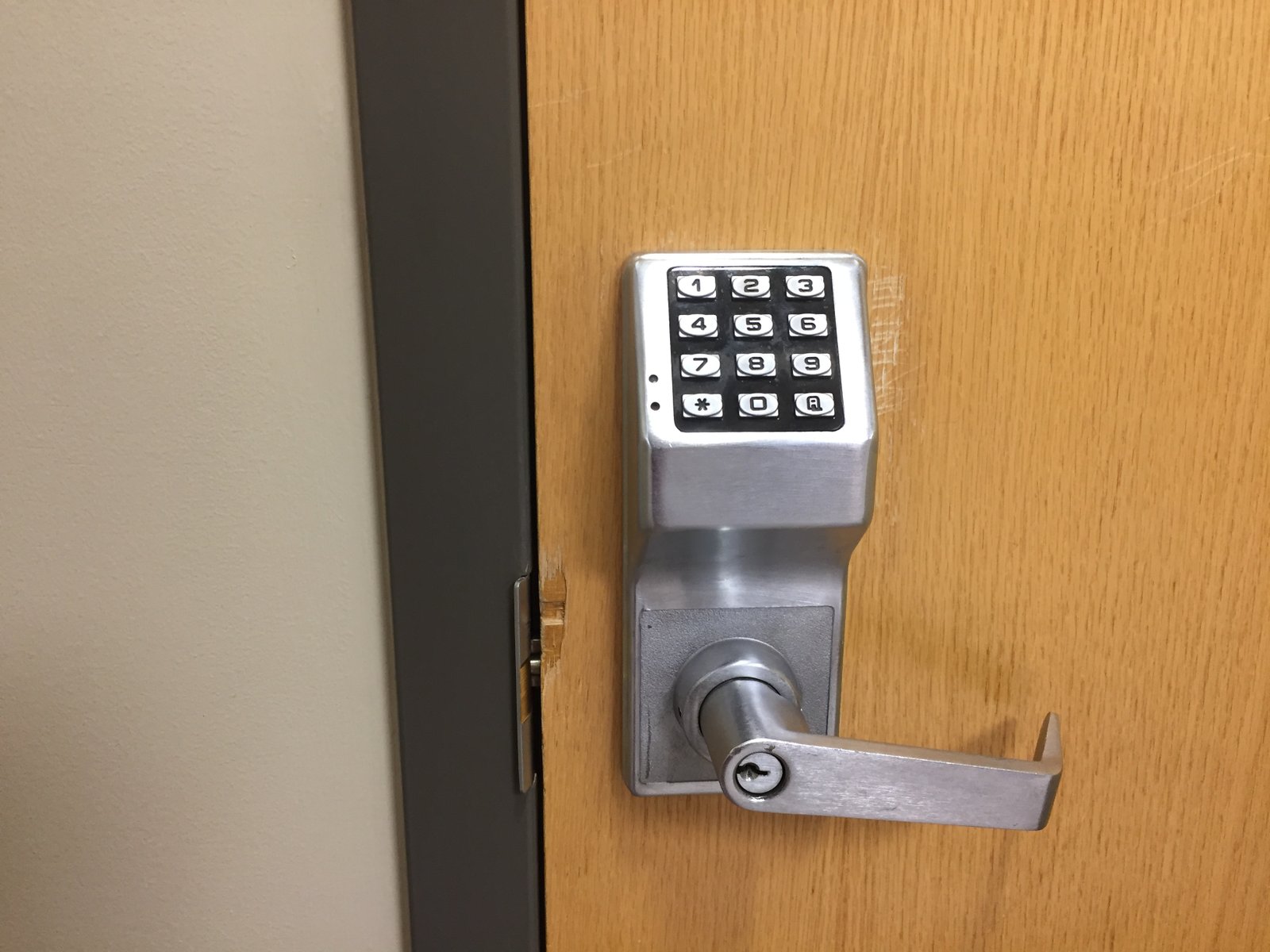Imagine a world where forgotten keys become a distant memory, where the need to hurriedly retrieve spare copies vanishes, and the haunting fear of a lockout fades into the abyss. Welcome to the realm of keypad locks, where the symphony of numbers dances harmoniously, granting or denying access to our most cherished spaces. From the humble front doors of homes to the fortified gates of high-security facilities, these seemingly unassuming devices hold the key, or rather, code, to a seamless and secure existence. In this comprehensive guide, we delve into the mesmerizing inner workings of keypad locks, unraveling their secrets one digital digit at a time. Hold on tight as we unlock the mysteries and embrace the fascinating technology that keeps us safe and sound, all through the magic of numbers.
Table of Contents
- Introduction: Understanding the Mechanics of a Keypad Lock
- The Inner Workings: Key Components and their Functions
- Decoding the Code: How Keyless Entry Systems Safeguard Access
- Optimal Usage and Maintenance: Tips for Ensuring Longevity
- Choosing the Right Keypad Lock: Factors to Consider in Making an Informed Decision
- Q&A
- In Summary

Introduction: Understanding the Mechanics of a Keypad Lock
Unlocking the Secrets:
Welcome to a world where keys are no longer necessary for access! In this introduction, we will delve into the intriguing mechanics of a keypad lock that has revolutionized the way we secure our spaces. Gone are the days of worrying about losing keys or fumbling with them in the dark. Keypad locks provide a convenient and reliable alternative, offering an elegant solution to the age-old problem of key management.
How does it work?
At its core, a keypad lock relies on a combination of electronic components, sturdy craftsmanship, and cutting-edge technology. Rather than requiring a physical key, these locks operate through the input of a predetermined code. The keypad itself is a user-friendly interface, allowing individuals to enter the correct code effortlessly. The combination of numbers, letters, or symbols acts as the digital key, granting access to the locked space.
Why opt for a keypad lock?
Keypad locks offer numerous advantages over traditional lock systems. Let’s explore a few:
- Convenience: Keypad locks eliminate the need to carry around physical keys, freeing your pockets and reducing the risk of misplaced or lost keys.
- Enhanced Security: With a keypad lock, you can say goodbye to the worries of unauthorized key duplication. The unique code required for access adds an extra layer of security to your home or office.
- Accessibility: Keypads are accessible to individuals with disabilities or those who struggle with traditional lock mechanisms, as code input requires minimal physical dexterity.
- Remote Access: Some advanced keypad locks offer the ability to control and monitor your lock remotely, providing added convenience and peace of mind.
- Customizability: Many keypad locks allow for multiple user codes, allowing you to grant personalized access to family members, friends, or employees.
So, if you’re ready to embrace the future of security without the hassle of keys, join us on this exploratory journey through the intricate mechanics of a keypad lock.

The Inner Workings: Key Components and their Functions
In the fascinating realm of machinery and technology, a myriad of key components work together harmoniously to bring complex systems to life. Understanding the inner workings of these components is crucial for both engineers and enthusiasts alike. Let us dive into the enchanting world of key components and explore their functions!
1. Power source: Acting as the lifeblood of any system, the power source provides the necessary energy to drive the entire mechanism. Whether it be electrical, mechanical, or even a combination of both, this vital component fuels the functionality of the system and powers its various elements.
2. Sensors: These remarkable devices possess an almost ethereal ability to detect and respond to changes in their surrounding environment. They serve as the eyes and ears of the system, capturing data and transforming it into meaningful information. From temperature and pressure to motion and light, sensors allow the system to adapt and make informed decisions.
3. Actuators: As the muscle of the operation, actuators convert energy into physical motion or force. With precision and agility, they translate instructions from the system into tangible actions. Whether it is rotating, pushing, or lifting, these components are the ones responsible for bringing movement to life.
4. Controllers: Like the brain orchestrating the symphony, controllers are the masterminds behind the operation. They analyze incoming data from sensors, make calculations, and send instructions to the actuators. With their intricate algorithms and programming, controllers facilitate coordination, ensuring the smooth functioning and stability of the system.
5. Interface: The bridge between humans and machines, the interface allows us to interact and control the system effortlessly. Whether it is a touch screen, keyboard, or joystick, this component provides a means for us to communicate our desires and receive feedback in return.
These key components intertwine, functioning harmoniously to create the intricate workings of a system. Like a well-choreographed dance, their collaboration is a testament to human ingenuity and innovation. So next time you encounter a machine, take a moment to appreciate the complex beauty that lies beneath its surface!
Decoding the Code: How Keyless Entry Systems Safeguard Access
In today’s world, keyless entry systems have become a vital component in safeguarding access to various spaces and places. These advanced systems rely on complex codes and innovative technology to ensure only authorized individuals can gain entry. Let’s delve into the fascinating world of keyless entry systems and uncover how they work to protect our security.
Keyless entry systems utilize a series of carefully crafted codes and encryption algorithms to grant or deny access to a premises. By removing the need for traditional keys, these systems offer numerous advantages such as enhanced convenience, flexibility, and improved security. With the ability to assign unique codes to different individuals, access can be tightly controlled, limiting unauthorized entry.
Understanding the inner workings of keyless entry systems reveals their efficiency. When an individual approaches a keyless entry point, a communication process is initiated between the system and the person seeking access. Through an encrypted channel, the system decodes the entered code or credential to verify its authenticity. If the code matches an authorized entry in the system’s database, access is granted through various means, including electronic locks or automatic gates.
Keyless entry systems go beyond traditional locks and keys, providing a sophisticated and robust solution for safeguarding access. Whether it’s securing a residence, commercial establishment, or even a vehicle, the intricate codes and algorithms embedded within these systems ensure peace of mind and protection against unauthorized entry.
Advantages of Keyless Entry Systems:
- Convenience without traditional keys
- Flexibility to assign and revoke access easily
- Better control over who enters a premises
- Increased security through encryption and authentication
- Efficient and seamless access for authorized individuals
By decoding the code behind keyless entry systems, we gain a deeper appreciation for the technology that safeguards our access. With their ability to provide secure and convenient entry, these systems are revolutionizing the way we protect our surroundings.
Optimal Usage and Maintenance: Tips for Ensuring Longevity
When it comes to maximizing the lifespan of your belongings, proper usage and maintenance play a crucial role. By following a few simple guidelines, you can significantly extend the longevity of your cherished items:
- Read the instruction manuals carefully and familiarize yourself with the proper usage techniques. This will help you avoid any unnecessary wear and tear caused by improper handling.
- Regularly clean and lubricate your belongings. This not only maintains their appearance but also ensures that they function smoothly and efficiently.
- Protect your items from extreme temperatures and harsh weather conditions. Direct exposure to sunlight, excessive humidity, or extreme cold can lead to damage over time.
- Store your belongings in a safe and secure place to avoid accidental damage or theft. Consider using protective covers, cases, or suitable storage containers to prevent scratches or impacts.
- Perform routine inspections to identify any signs of wear or potential issues early on. Timely maintenance and repairs can save you from more costly problems down the line.
By incorporating these practices into your daily routine, you can ensure that your beloved possessions withstand the test of time, serving you well for years to come.
Choosing the Right Keypad Lock: Factors to Consider in Making an Informed Decision
Factors to Consider in Making an Informed Decision
When it comes to choosing the right keypad lock for your home or office, there are several important factors to consider. By taking these factors into account, you can ensure that you make an informed decision that meets your specific security needs.
1. Security Features: The first and foremost consideration should be the security features offered by the keypad lock. Look for locks that have advanced encryption technology, tamper-proof mechanisms, and a high level of resistance against hacking or brute force attacks.
2. Durability and Weather Resistance: Another crucial factor to consider is the durability and weather resistance of the keypad lock. It should be able to withstand extreme temperatures, humidity, and other outdoor elements without compromising its functionality or security.
3. Ease of Use: A keypad lock should be user-friendly and convenient to operate. Look for models that have a backlit keypad for easy use in low-light conditions, and consider whether you prefer a lock with physical buttons or a touchscreen interface.
4. Battery Life: Since keypad locks rely on batteries to function, it’s important to choose a model that has a long-lasting battery life. Consider locks that offer low battery indicators or even those that have a backup power option.
5. Compatibility: Lastly, ensure that the keypad lock you choose is compatible with your existing door hardware, or if you’re planning to replace your entire lock, make sure it suits the door’s specifications and requirements.
By considering these factors, you can confidently select the perfect keypad lock that provides optimal security, durability, ease of use, and compatibility for your specific needs.
Q&A
What is a keypad lock?
A keypad lock is a type of electronic lock that allows access by entering a numeric code on a keypad. It eliminates the need for keys and offers convenience and security.
How does a keypad lock work?
A keypad lock works by using an electronic circuit to interpret the input from the keypad. When a correct code is entered, the circuit activates an electric motor to retract or extend the locking mechanism.
Is a keypad lock secure?
Keypad locks can be highly secure when coupled with strong passwords and encryption technology. However, it is crucial to choose a reputable brand that implements advanced security features to minimize the risk of hacking or code-guessing.
Can keypad locks be easily hacked?
While keypad locks are generally secure, some models can be vulnerable to hacking attempts. Advanced hackers might attempt brute force attacks, where they systematically try different combinations until they find the correct code. Selecting a lock with built-in anti-hacking measures can greatly reduce this risk.
Can a keypad lock be installed anywhere?
Keypad locks can be installed on most doors that have a compatible locking mechanism. From residential homes to office buildings and even vehicles, keypad locks can provide secure access control in a variety of settings.
Are keypad locks difficult to install?
Keypad locks are relatively straightforward to install and often come with user-friendly instructions. However, for those who are unfamiliar with electrical wiring or lock installation, it may be best to seek the assistance of a professional locksmith to ensure proper installation.
What happens if the battery dies in a keypad lock?
In the event of a dead battery, most keypad locks have a backup power option. This can be a physical key override or a built-in battery backup system. It is important to regularly monitor battery life and replace them promptly to avoid being locked out due to power loss.
Can a keypad lock be used alongside other access control systems?
Yes, a keypad lock can be integrated into a wider access control system, such as card readers or biometric scanners. This allows for additional layers of security and flexibility in managing access to a particular area or building.
In Summary
As we conclude this comprehensive guide on keypad locks, we now have a deeper understanding of the intricate mechanisms that ensure the security of our homes and businesses. These sleek, unassuming devices have quietly revolutionized the way we protect our loved ones and our valuable possessions.
In a world where technology continuously evolves, the keypad lock has remained a steadfast guardian, embracing both simplicity and sophistication. From the familiar touch of buttons to the whispering symphony of hidden circuits, every aspect has been carefully designed to seamlessly blend functionality with aesthetics.
As we marveled at the precise dance of codes and numbers, we unraveled the secrets that lie beneath the surface. We learned how these digital sentinels guard our sanctuaries with unwavering devotion, enabling seamless access for those with the correct combination while defiantly thwarting the efforts of unauthorized intruders.
From the humble beginnings of mechanical keypad locks to the cutting-edge biometric marvels of today, we explored the remarkable evolution of this captivating technology. With your newfound knowledge, you can confidently navigate through the realm of keypad locks, choosing the perfect guardian for your unique needs.
Remember, a keypad lock is more than a mere compilation of buttons and wires; it is a symbol of security, a trusted ally, and a silent testament to human ingenuity. So, the next time you approach your keypad lock, take a moment to appreciate the elegant dance of science and art that grants you access to your private domain.
As you depart from this guide, armed with a wealth of knowledge, we encourage you to explore further, for the world of home security is constantly evolving. Embrace the possibilities that arise from the fusion of technology and imagination, for in this realm, the only limit is your own creativity.
Farewell, dear reader, and may your keypad lock forever safeguard your home, granting you peace of mind as you weave the tapestry of your life.
As an affiliate, my content may feature links to products I personally use and recommend. By taking action, like subscribing or making a purchase, you’ll be supporting my work and fueling my taco cravings at the same time. Win-win, right?
Want to read more? Check out our Affiliate Disclosure page.